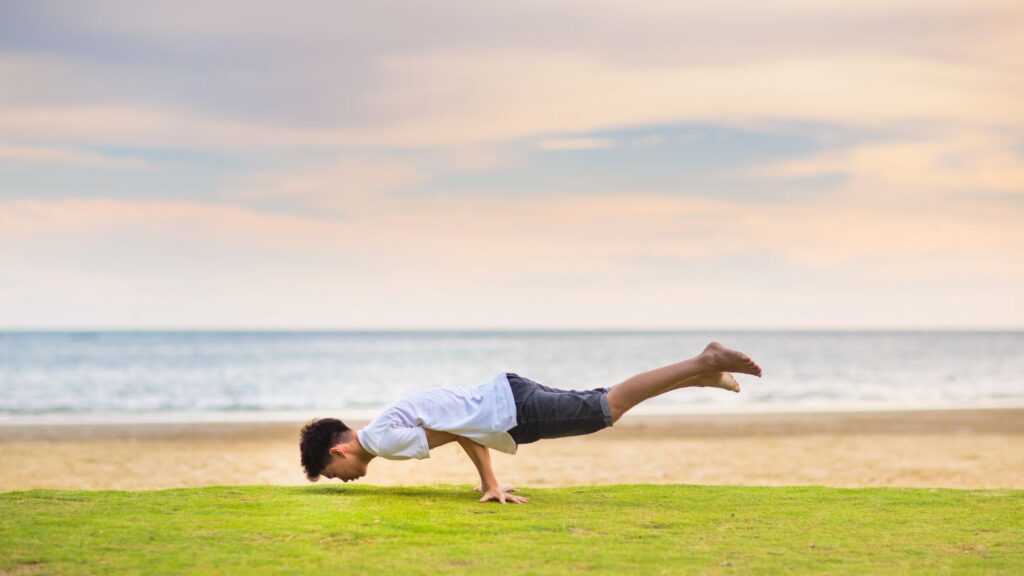Calisthenics, a form of strength training consisting of a variety of movements that exercise large muscle groups, is a fantastic way to get fit using minimal equipment. The beauty of calisthenics is that it can be done anywhere, and what better place to exercise than the great outdoors? This comprehensive blog will guide you through mastering bodyweight exercises in natural settings, discussing the benefits of outdoor workouts, and providing tips to maximize your calisthenic routine.
Exploring Calisthenics: Mastering Bodyweight Exercises in the Great Outdoors
Understanding Calisthenics
Calisthenics comes from the Greek words ‘kalos’ (beauty) and ‘sthenos’ (strength). It’s not just about physical strength but also about the beauty of movement. With roots in ancient Greece, this form of exercise focuses on mastering control over lifting and moving one’s body weight.
Benefits of Outdoor Calisthenics
- Connection with Nature: Exercising outdoors provides a mental health boost beyond that of indoor gyms. Nature’s ambiance enhances mood and reduces stress.
- Vitamin D Exposure: Outdoor exercise provides an opportunity to soak up Vitamin D from the sun, crucial for bone health and metabolic function.
- Varied Terrain: The outdoors offers varying terrains and landscapes, providing natural resistance and challenges that can enhance your workout.
- Fresh Air: Fresh air can rejuvenate the body, providing a refreshing environment compared to the stale air of indoor gyms.
Basic Calisthenic Exercises
- Push-Ups: Great for the chest, shoulders, and triceps. The outdoors allows for variations like incline push-ups using a bench or tree.
- Pull-Ups: Find a sturdy tree branch or outdoor pull-up bar. Pull-ups work the back, shoulders, and arms.
- Squats: Perfect for the legs and glutes. Try one-legged squats for an added challenge.
- Planks: Excellent for core stability. The uneven ground can provide an extra balance challenge.
- Dips: Use a bench or low wall. Dips target the triceps and shoulders.

Advanced Calisthenic Movements
As you progress, you might want to try more advanced movements:
- Muscle-Ups: An advanced pull-up that transitions into a dip.
- Human Flag: Holding onto a vertical pole, lift your body parallel to the ground.
- Front and Back Lever: Suspended from a bar, hold your body straight and horizontal.
Safety and Progression
- Start Slow: If you’re new to calisthenics, start with the basics. Ensure your form is correct to avoid injury.
- Listen to Your Body: Rest when needed, and don’t push into painful movements.
- Progress Gradually: Increase the intensity or volume of your workouts gradually over time.
Setting Up Your Outdoor Gym
Look for local parks with fitness stations, or simply use what’s available: benches, trees, and playground equipment can all be used creatively for a full-body workout.
Workout Structure
- Warm-Up: Begin with a light jog or dynamic stretching to prepare your body.
- Main Set: Cycle through your chosen exercises, focusing on form and control.
- Cool Down: End with static stretching to aid in recovery.

Nutrition and Hydration
Proper nutrition and hydration are vital for maximizing the benefits of calisthenics, a physically demanding form of exercise that uses bodyweight for resistance. Nutritionally, focusing on a balanced diet rich in proteins, healthy fats, and complex carbohydrates is crucial. Proteins are essential for muscle repair and growth, particularly after intense workouts. Healthy fats provide sustained energy, while complex carbohydrates fuel your muscles and brain.
Hydration is equally important; water regulates body temperature, lubricates joints, and helps transport nutrients to give you energy. During workouts, especially outdoors, you may need to increase your water intake to compensate for fluid loss through sweat. Additionally, incorporating electrolytes can help maintain the body’s balance of fluids. Remember, individual needs can vary greatly, so listen to your body and adjust your nutrition and hydration accordingly to support your calisthenic endeavors effectively.
Adapting to Weather
Adapting to weather is crucial in calisthenics, especially since it often takes place outdoors. Weather conditions can significantly impact performance and safety. In hot weather, the body works harder to cool down, leading to quicker dehydration and potential heat-related illnesses. Conversely, cold weather can increase the risk of muscle stiffness and injury.
Adapting your routine to the weather means staying hydrated, adjusting the intensity of workouts, wearing appropriate clothing, and utilizing the time of day when the temperature is most favorable. Being mindful of weather conditions and preparing accordingly ensures that your training remains effective and safe, allowing you to enjoy the benefits of calisthenics year-round without risking your health.
Calisthenics offers profound mental benefits alongside its physical perks. Engaging in this form of exercise can significantly reduce stress, anxiety, and depression, thanks to the release of endorphins, known as ‘feel-good’ hormones. The focus required for mastering movements enhances mental clarity and sharpens cognitive function. As progress is made, the visible improvements in strength and skill boost self-esteem and confidence.
The discipline and persistence needed to achieve advanced calisthenic skills foster a growth mindset, teaching patience and resilience. Moreover, practicing in a group or community setting can provide a sense of belonging and social support, further enhancing mental well-being. Overall, calisthenics not only strengthens the body but also fortifies the mind, making it a holistic approach to health and fitness.

Conclusion
Calisthenics offers a unique way to connect with nature while improving physical strength, flexibility, and endurance. It’s about mastering control over your body and appreciating what it can do. Whether you’re doing push-ups in your local park or a human flag off a tree branch, the world is your gym.
Remember, everyone starts somewhere, and progression is a personal journey. Enjoy the process, challenge yourself, and revel in the strength and beauty of movement in the great outdoors.
Also read: How to Stay Fit While Traveling: Your Ultimate Guide
